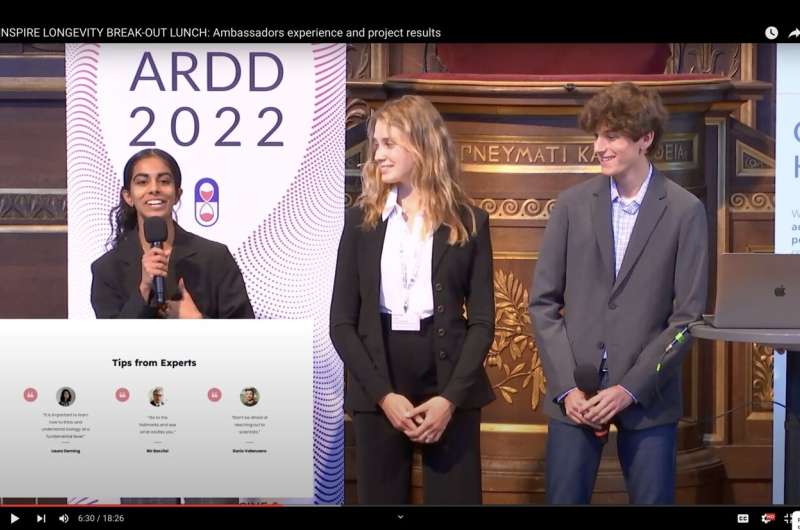This article has been reviewed according to Science X'seditorial processandpolicies.Editorshave highlighted the following attributes while ensuring the content's credibility:
fact-checked
trusted source
proofread
High school student researchers find new brain tumor drug targets using AI

Glioblastoma multiforme (GBM) is the most aggressive and common malignant type of brain tumor, accounting for 16% of all primary brain tumors. Andrea Olsen from Oslo, Norway; Zachary Harpaz from Boca Raton, Florida; and Chris Ren from Shanghai, China have conducted a study in which they used a generative artificial intelligence (AI) engine for target discovery to identify new therapeutic targets for GBM. The findings were published on April 26 in the journalAging.
Olsen, a student at Sevenoaks School in Kent, U.K., began interning at Insilico Medicine in 2021, after discovering her interest in neurobiology and technology. For the current paper, the fifth scientific paper she has co-authored before turning eighteen, she and other researchers used PandaOmics to screen datasets from the Gene Expression Omnibus repository maintained by the National Center for Biotechnology Information and found new therapeutic targets implicated for treating both aging andglioblastoma multiforme.
While there would seem to be a clear connection between aging and cancer, Olsen says their findings were more nuanced. "Sometimes, instead of aging, the body switches to cancer mechanisms, which was really interesting to discover." She hypothesized that "the body is trying to preserve itself in a way that it is switching back to embryonic processes of cell division." GBM is caused by a genetic mutation that leads to uncontrolled growth of glial cells, or cells that surround neurons in the brain. Even with existing therapies, the median survival for GBM patients is only 15 months.
Harpaz, a student at Pine Crest School in Ft. Lauderdale, had an early interest in computer science and AI and soon developed a passion for biology as well. "I wanted to combine my two favorite topics,computer scienceand biology, into what I think is the most interesting field of biology—aging research," Harpaz says. He discovered generative AIdrug discoverycompany Insilico Medicine whose founder and CEO, Alex Zhavoronkov, Ph.D., connected him with Olsen. The two young researchers began collaborating on the glioblastoma project and ultimately presented findings at theAging Research and Drug Discovery (ARDD)conference in Copenhagen, where they together launched the Youth Longevity Association (TYLA).
In this latest paper, they and Ren used PandaOmics to analyze the genes and identified three that were strongly correlated with both aging and glioblastoma and could serve as potential therapeutic targets for new drugs.
“我们选择的基因重叠highly correlated in 11 of the 12 datasets, and we split our data into young, middle aged, and senior groups," said Harpaz. "We mapped this to the importance of the gene expression to survival." After identifying two genetic targets for glioblastoma and aging—CNGA3 and GLUD1—they cross-referenced their findings with earlier findings from Insilico around genes strongly correlated with aging and identified a third target—SIRT1.
The students say they are eager to continue their studies in AI and biology into college and to move the GBM research forward from target discovery to drug development.
"The best way to take this research further is going to be using Insilico's Chemistry42 software, where we can take the targets we identified through PandaOmics and generatesmall molecules, potential drugs, with these targets that have the potential to treat glioblastoma and aging at the same time," says Harpaz.
Prior to her internship at Insilico, Olsen says, "I never knew that AI could be so helpful in finding completely new therapeutic targets. For me, that was an incredible opportunity to dive into the field of research, aging, longevity, and neuroscience. It really kick-started my entire career."
"I am truly impressed by the commitment of these young researchers," says Zhavoronkov. "I hope their work will inspire otheryoung peopleexcited about science and technology to look at how they can use AI tools to discover new targets and treatments for both aging and disease."
更多的信息:Andrea Olsen et al, Identification of dual-purpose therapeutic targets implicated in aging and glioblastoma multiforme using PandaOmics—an AI-enabled biological target discovery platform,Aging(2023).DOI: 10.18632/aging.204678


















